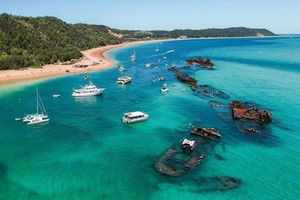
Within minutes, the tide line covering the base of the torii gate drains outwards and scores of day trippers head down the stairs and walk across to the structure that dominates the skyline. At this time of day there’s only a short window on the low tide to be able to walk out and physically touch one of the most revered structures in Japan - the O-torii Gate at Miyajima. It’s the largest torii gate in Japan at 16 metres and stands sentinel over the island and its most famous attraction, the Itsukushima Shrine which is also built over the water. Wild deer follow the people down into the bay and they join the scene and mingle among the happy-snappers who patiently take turns at photographing the torii gate in close up.
It’s the fascinating centrepiece of a small mountainous island which has been revered as a holy place for more than 1,400 years. Today more than a dozen temple and shrine complexes, along with scores of pagodas and historical buildings, occupy the 20 square kms of Miyajima and are connected by a series of serene walking trails. The Itsukushima Shrine is believed to have been originally built in 593, with the current shrine pavilions constructed in 1168, and it became a UNESCO World Heritage Site in 1996. It’s located in a small inlet, about a 10 minute walk from the ferry terminal in the main town, and is made up of multiple buildings including a prayer hall, main hall and theatre stage and each are connected by boardwalks over the sea.
O-Torii Gate
Miyajima is one of the most sacred sites in Japan, and remains a symbol of the country’s ancient traditions. And If you’re a loyal Virgin Australia customer, the airline is offering new flights from Brisbane to Tokyo’s Haneda Airport starting on March 29, 2020, with connections to Hiroshima, the nearest gateway, by air or train. The O-torii Gate, or Grand Gate, is a further 200 metres out in the Seto Inland Sea and together they were designated as one of the “top three views in Japan” by the scholar Hayashi Razan in 1643. While officially called Itsukushima, the island itself is more commonly referred to as Miyajima, which translates to “Shrine Island” and the Daisho-in Temple is another important and beautiful complex. It’s less visited even though it’s only a five minute walk from Itsukushima Shrine, and it’s regarded as one of the most prestigious Shingon Bhuddist Temples in Japan.
Like most temple and shrine complexes on Miyajima, there are multiple buildings and halls displaying ancient statues and artefacts, but the most uplifting experience is to simply relax and enjoy the tranquil atmosphere of the grounds. From Daisho-in, a hiking trail leads to the summit of Mt Misen at a height of just over 500 metres and the reward for the one and a half hour hike is not just a great view, but more ancient temples and walking trails at the summit. Most visitors tend to stick to the lower levels near the sea where the Goju-no-to Pagoda, or Five-Storied Pagoda, towers over the main town at 27 metres. The Pagoda was built in 1407 and is used to enshrine a Bhuddist Statue and it’s painted a vermilion colour to match the Itsukushima Shrine.
Miyajima Town
The main town itself stretches along the waterfront from the ferry terminal to Itsukushima Shrine and is a throwback to the Japanese Edo-era, which is rare in modern day Japan, and the local government has ensured the town retains its classical look with restrictions on construction and renovations. The wild deer also wander into the town, obviously looking for handouts, and their favourite trick with tourists is to “pickpocket” them when they have their backs turned, which means they’ll happily snuffle into a back pocket and eat whatever is inside including wallets and handkerchiefs.
The deer love to hang out on the waterfront where there are a series of restaurants, and these are a little pricey, but a block or two back are some more authentic eateries and shops. Along the Omotesando Shopping Arcade, which is one street back from the sea, local vendors barbecue oysters (a local delicacy) while traditional tea joints and souvenir shops compete for tourist trade. Most visitors to Miyajima are day trippers, often in tour groups, and after about 5pm they often disappear and the island takes on an even more serene atmosphere. This is where staying in a ryokan can offer an unforgettable cultural experience. After the crowds have gone, you join the locals who turn out for the lighting of the lanterns at sunset, dressed in a yukata, or traditional gown, and slippers.
- By:
- Ben Hall













